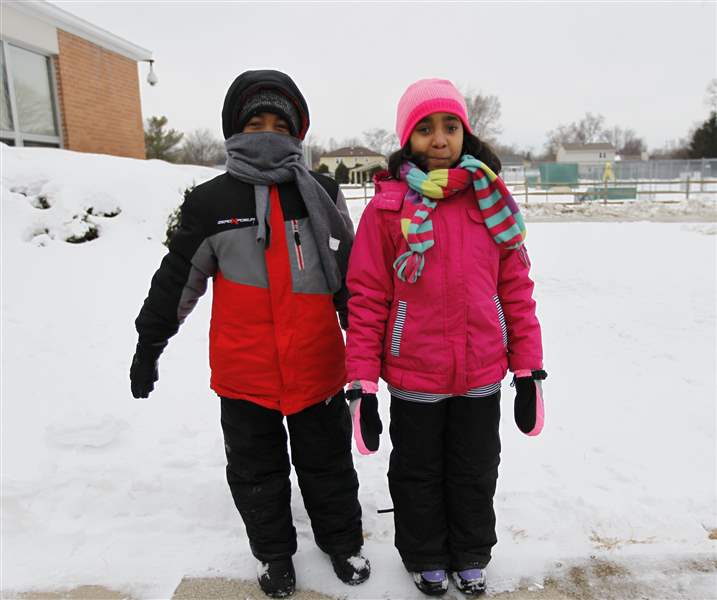
Layers: Dressing to beat the cold
Best way to stay warm is to keep adding clothes
2/3/2014
Twins Austin, left, and Erin Proctor, both third graders, are dressed for the weather.
The Blade/Jetta Fraser
Buy This Image

Most people want the worst of this winter to be behind us. But no matter what Punxsutawney Phil saw Sunday, the first day of spring still isn’t until March 20. So if the weather forces superintendents to again close schools, appropriately dressing children to protect them from freezing temperatures this time of year is a priority.
And whether you’re a doctor, parent, retailer, or just someone who wants to keep warm, the key to not having one’s skin exposed to the dangerously cold weather is layering clothing. Indeed, one might think the answer to protecting our children from the intense cold and significant snowfall as the region has experienced lately is more philosophical, but it’s not.
“Overall, layering is always good,” said Dr. Michael Omori, pediatric emergency room physician at Mercy St. Vincent Medical Center. “It provides versatility, especially if you’re changing from a very cold to a less cold environment.”
Dr. Eric Rader, of Perrysburg Pediatrics, a ProMedica practice, agreed, then added that the first layer of clothing should be cotton because it absorbs moisture.
“Layering is a big key to try to keep children warm this time of year,” Dr. Rader, a doctor of osteopathy, said. Layering is vital when children walk to school because the layers “trap heat” and keeps the body warm.
“I’m a big proponent of layers,” said Dave Stockwell, manager at Dillards. “Anytime you can layer, it always protects them.”
In fact, Mr. Stockwell finds that's what parents do to protect their youngsters from extreme weather: Dress them in different layers, beginning with lightweight garments that fit snuggly, such as tights or leggings for girls and long johns for boys. Long-sleeve shirts are then topped with their ready-to-wear shirt and next is a sweater, he said. The whole point, he said, is to help them "retain body heat and keep you warm."
Dr. Omori said garments made of wool and synthetics that help to insulate the body are preferences.
After the sweater, children often wear undercoats, Mr. Stockwell said, or a light-weight jacket before putting on their outer coat. Waist- length jackets and coats don't fare as well probably because they don't protect little bodies from the cold as much. Longer coats that reach about mid-thigh is a preferred length.
"Down or synthetic fibers, we sell more of those this time of year than wool coats," the store manager said. "It's not as dressy but it's more functional."

Though Dr. Omori hasn't seen many patients with frost bite on their faces, hands and feet are another story.
"Most patients seen now have frost bite on their hands and feet. Apparently, people are not aware of the process of frost bite when it is occurring. They think they are just cold, and you look at their fingers and they are clearly frost bitten," Dr. Omori said. "Just be cognizant of the conditions outside, and send kids out appropriately attired."
Mr. Stockwell said most young children still seem to prefer gloves than mittens. If there's a choice, little girls like mittens. And if wearing gloves in extreme weather, water resistant or water proof pairs are preferred. Dr. Omori also said that choosing mittens rather than gloves for youngsters who walk to school better protects their little fingers.
"Mittens are much warmer than gloves from a warmth standpoint because the fingers are not isolated, but they are together and they can warm each other," Dr. Omori said. However, if a child has to keep taking off the mittens, "that defeats the purpose."
Some fashion boots are not just for looks, as some also protect from moisture and keep little feet warm, especially those that have sheepskin lining, Mr. Stockwell said. So pull on the boots after putting on a pair of tights for girls, and then for boys, a pair of wool or thick cotton socks.
And tell young boys not to walk to school wearing a baseball cap because it doesn’t provide enough protection in freezing temperatures. Not only are stocking or skull caps practical, they are fashionable, too, Mr. Stockwell said. Dr. Rader said knit hats can be pulled down to cover the ears, and thicker scarves help to protect the neck area that's exposed to the weather.
"Just be smart and limit your exposure and make sure you are properly attired," Dr. Omori said. "Stay warm, and inside, if possible."
After all, frost bite can occur "within minutes," Dr. Rader said, and if the wind chill is -50, it wouldn't take long to develop symptoms of frost bite. "The areas most prone on kids are their ears, cheeks, fingers, and toes," he said.
"The biggest thing is prevention. Bundle up with layers to prevent frost bite from happening," Dr. Rader added. "The biggest key is if you see skin, cover it."
Contact Rose Russell at rrussell@theblade.com, or 419-724-6178.